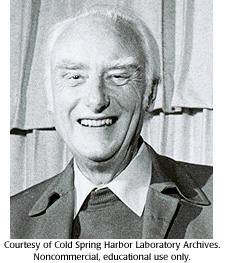டிஎன்ஏ-மூலக்கூறு, முறுக்கப்பட்ட ஏணி போன்று வடிவமைக்கப்பட்டுள்ளது.



 James Watson and Francis Crick solved the structure of DNA. Other scientists, like Rosalind Franklin and Maurice Wilkins, also contributed to this discovery.
James Watson and Francis Crick solved the structure of DNA. Other scientists, like Rosalind Franklin and Maurice Wilkins, also contributed to this discovery.
Francis Crick (1916-2004)

Francis Harry Compton Crick was born in a small town near Northampton, England. As a child, Crick was very inquisitive and he read all of the books of Children's Encyclopedia that his parents bought him. He found the sections that dealt with science most interesting. This interest led to "kitchen" experiments and eventually serious study and a second-class Honours degree in physics at University College, London.
The physics Crick learned in class was already out of date, so he taught himself the rudiments of quantum mechanics while doing graduate research on the viscosity of water. World War II interrupted his graduate studies. During the war, Crick worked for the Admiralty doing mostly research and design on magnetic and acoustic mines.
When the war ended, Crick continued to work at the Admiralty but he knew he did not want to design weapons for the rest of his life. The problem was that he was unsure what he did want to do. In the end, he decided to enter the life sciences. He liked reading, thinking, and talking about the new discoveries being made in the life sciences. Crick found that "what you are really interested in is what you gossip about." To pursue his interests, Crick visited several labs and scientists. He finally settled in for a two year stint at Strangeways Laboratory where he did work on the effects of magnetism on chick fibroblast cells.
In 1947, armed with this biology experience, Crick joined Max Perutz at the Cavendish Laboratory in Cambridge. Sir Lawrence Bragg was directing a new unit of the Laboratory where they were using X-ray crystallography to study protein structure. Max Perutz was working on the structure of hemoglobin and Crick's thesis project was on X-ray diffraction of proteins.
In 1951, Francis Crick met James Watson who was visiting Cambridge. Although Crick was twelve years older, he and Watson "hit it off immediately." Watson ended up staying at Cavendish, and using available X-ray data and model building, the two solved the structure of DNA. The classic paper was published in Nature in April 1953. A flip of the coin decided the order of the names on the paper. Francis Crick, James Watson and Maurice Wilkins shared the 1962 Nobel Prize for Physiology or Medicine for solving the structure of DNA. Maurice Wilkins and Rosalind Franklin provided some of the X-ray crystallographic data.
After the "double helix" model, there were still questions about how DNA directed the synthesis of proteins. Crick and some of his fellow scientists, including James Watson, were members of the informal "RNA tie club," whose purpose was "to solve the riddle of RNA structure, and to understand the way it builds proteins." The club focused on the "Central Dogma" where DNA was the storehouse of genetic information and RNA was the bridge that transferred this information from the nucleus to the cytoplasm where proteins were made. The theory of RNA coding was debated and discussed, and in 1961, Francis Crick and Sydney Brenner provided genetic proof that a triplet code was used in reading genetic material.
For most of his career, Crick was at Cambridge working for the Medical Research Council. In 1976, Crick moved to the Salk Institute in La Jolla where he focused his research on developmental neurobiology. In 1988, he wrote about his experiences in What Mad Pursuit: A Personal View of Scientific Discovery. Crick has been described as having a keen intellect and a dry, British sense of humor.


DNA was first crystallized in the late 70's — remember, the 1953 X-ray data were from DNA fibers. So, the real "proof" for the Watson-Crick model of DNA came in 1982 after the B-form of DNA was crystallized and the X-ray pattern was solved.

If the DNA of one human cell is stretched out, it would be almost 6 feet long and contain over three billion base pairs. How does all this fit into the nucleus of one cell?
 உட்கருவின் முக்கிய மூலக்கூறுகள் டிஎன்ஏ மற்றும் புரதங்களாகும்.
உட்கருவின் முக்கிய மூலக்கூறுகள் டிஎன்ஏ மற்றும் புரதங்களாகும். ஒரு மரபணு ஒரு புரதத்தை உருவாக்குகிறது.
ஒரு மரபணு ஒரு புரதத்தை உருவாக்குகிறது. ஒரு மரபணு டிஎன்ஏ' வால் ஆனது.
ஒரு மரபணு டிஎன்ஏ' வால் ஆனது. பாக்டீரியா மற்றும் வைரஸ்களிலும் டிஎன்ஏ'கள் உள்ளன.
பாக்டீரியா மற்றும் வைரஸ்களிலும் டிஎன்ஏ'கள் உள்ளன. டிஎன்ஏ-மூலக்கூறு, முறுக்கப்பட்ட ஏணி போன்று வடிவமைக்கப்பட்டுள்ளது.
டிஎன்ஏ-மூலக்கூறு, முறுக்கப்பட்ட ஏணி போன்று வடிவமைக்கப்பட்டுள்ளது. டிஎன்ஏ ஏணியின் ஒரு பாதி மற்றொன்றுக்கு வார்ப்புருவாகும்.
டிஎன்ஏ ஏணியின் ஒரு பாதி மற்றொன்றுக்கு வார்ப்புருவாகும்.  ஆர்என்ஏ'வானது, டிஎன்ஏ' மற்றும் புரதத்திற்கு இடையே ஓர் பாலமாக உள்ளது.
ஆர்என்ஏ'வானது, டிஎன்ஏ' மற்றும் புரதத்திற்கு இடையே ஓர் பாலமாக உள்ளது. டிஎன்ஏ'யின் வார்த்தைகள் மூன்று எழுத்துகளால் ஆனவையாகும்.
டிஎன்ஏ'யின் வார்த்தைகள் மூன்று எழுத்துகளால் ஆனவையாகும். டிஎன்ஏ நியூக்ளியோடைட்களின் வரிசையே மரபணுவாகும்.
டிஎன்ஏ நியூக்ளியோடைட்களின் வரிசையே மரபணுவாகும். ஆர்என்ஏ தகவல்கள் சில நேரங்களில் திருத்தியமைக்கப்படுகின்றன.
ஆர்என்ஏ தகவல்கள் சில நேரங்களில் திருத்தியமைக்கப்படுகின்றன. சில வைரஸ்கள் மரபணு தகவல்களை ஆர்என்ஏ'வில் சேமிக்கும்.
சில வைரஸ்கள் மரபணு தகவல்களை ஆர்என்ஏ'வில் சேமிக்கும். ஆர்என்ஏ'களே முதலிலெழுந்த மரபணு மூலக்கூறுகளாகும்.
ஆர்என்ஏ'களே முதலிலெழுந்த மரபணு மூலக்கூறுகளாகும்.  பிறழ்வுகளானவை, மரபணு தகவல்களின் மாற்றங்களாகும்.
பிறழ்வுகளானவை, மரபணு தகவல்களின் மாற்றங்களாகும்.  சில வகையான பிறழ்வுகள் தானாகவே சீர்திருத்தப்படும்.
சில வகையான பிறழ்வுகள் தானாகவே சீர்திருத்தப்படும்.